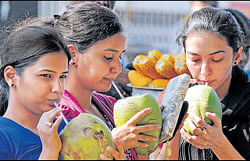
If the summer is getting unbearable this year, blame high density of dust particles and pollutants in the air.
Nights offer no respite from the heat and this may only get worse in April as the days get longer, warn meteorological experts.
The short winter that preceded the current summer had given early signs of what was in store. Though the common man is of the opinion that there is an increase in heat during this summer, experts differ. V S Prakash, director, Karnataka State Natural Disaster Management Cell (KSNDMC), says that the mercury in Bangalore has not soared as felt by the people.
Bangalore temperature on March 29 was 37 degrees Celsius, but as per the statistics available it was not an extremely hot day in March as the highest temperature in that month dates back to March 18, 1983, which was 37.5 degrees Celsius.
Blaming the increasing pollution for converting Bangalore into an oven, Dr M B Rajegowda, professor, Agro Meteorology, University of Agriculture Sciences, Bangalore, says: “The incoming solar radiation is more.”
“The outgoing radiation in the afternoon, which we term as terrestrial radiation, is trapped in the atmosphere by the dust particles, which retain the heat emitted. This is the reason for increasing humidity. The dust settled in atmosphere holds more quantum of heat. Therefore the heat continues even after 10 pm and might continue even until dawn.”
Rajegowda said the situation is more man-made than a natural phenomenon which is due to increase in burning fossil fuel, extensive use of coolant systems (air conditioners and refrigerators) and rampant felling trees.
The short winter is another reason which resulted in the summer temperature shooting up. It will lead to convectional rain. Agreeing with him, Dr Prakash said Bangalore may get a spell of reprieve within a couple of days. “ It is a natural phenomenon, once the temperature crosses 37 degrees, there will be a spell of rain and the cycle continues until the monsoon,” he said.
Extreme temperature
Other than Bangalore, cities like Chitradurga have witnessed extreme temperatures. Chitradurga recorded a temperature of 40 degrees Celsius on Friday, while the highest temperature recorded in March was 36 degrees Celsius on March 31, 1925. Similarly, Tumkur witnessed a temperature of 41 degrees Celsius on March 29, while its highest recorded temperature was 36.5 degrees on March 21, 1973.